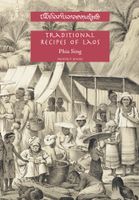Advertisement
Cooking Utensils
By Phia Sing
Published 1981
The typical Lao ‘stove’ is the charcoal-burning apparatus shown in the drawing below. It is called tao-lo. If a cook were using a wood fire, of logs instead of charcoal, the ‘stove’ would consist of three stones arranged to form a shelter and support (like a camper’s fire in the west) and would be called kon sao; or an iron tripod, called kiang.

The wok, used throughout South-East Asia and probably of Chinese origin, is maw hang in Laos, or maw kat-ta or (as in Thailand) just kat-ta.
The word for a steamer (the upper part) is houad. The drawing shows the traditional kind of steamer used in Laos. The name for its lower part is maw nung (maw meaning pot, and nung meaning steam). A modern steamer, made of aluminium, would be called houad lek, and may have one or two steaming compartments set over its lower part. When Phia Sing gives instructions for steaming something he usually says that it is to be steamed in a houad or by means of what he calls a steaming rack. We have omitted this last phrase in the translation, when it is simply mentioned as an alternative, to avoid constant repetition of something which might sound mysterious. However, we must explain here what he meant. His ‘steaming rack’ (lang tung) is not traditionally Lao, but Chinese, and is to be seen in Chinese restaurants the world over. It consists of a stack of circular bamboo recipients, fitting on top of each other and permitting the passage of steam all the way up, so that different dishes can be cooked simultaneously in the various ‘layers’.

